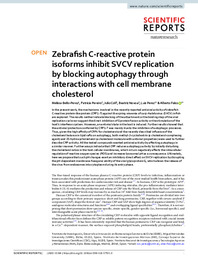Por favor, use este identificador para citar o enlazar este ítem:
https://hdl.handle.net/11000/6894Registro completo de metadatos
| Campo DC | Valor | Lengua/Idioma |
|---|---|---|
| dc.contributor.author | Belló Pérez, Melissa | - |
| dc.contributor.author | Pereiro, Patricia | - |
| dc.contributor.author | Coll Morales, Julio | - |
| dc.contributor.author | Novoa, Beatriz | - |
| dc.contributor.author | Pérez, Luis | - |
| dc.contributor.author | Falcó Graciá, Juan Alberto | - |
| dc.date.accessioned | 2021-01-14T08:17:45Z | - |
| dc.date.available | 2021-01-14T08:17:45Z | - |
| dc.date.created | 2020-01-17 | - |
| dc.date.issued | 2021-01-14 | - |
| dc.identifier.issn | 2045-1222 | - |
| dc.identifier.uri | http://hdl.handle.net/11000/6894 | - |
| dc.description.abstract | In the present work, the mechanisms involved in the recently reported antiviral activity of zebrafish C-reactive protein-like protein (CRP1-7) against the spring viraemia of carp rhabdovirus (SVCV) in fish are explored. The results neither indicate blocking of the attachment or the binding step of the viral replication cycle nor suggest the direct inhibition of G protein fusion activity or the stimulation of the host’s interferon system. However, an antiviral state in the host is induced. Further results showed that the antiviral protection conferred by CRP1-7 was mainly due to the inhibition of autophagic processes. Thus, given the high affinity of CRPs for cholesterol and the recently described influence of the cholesterol balance in lipid rafts on autophagy, both methyl-β-cyclodextrin (a cholesterol-complexing agent) and 25-hydroxycholesterol (a cholesterol molecule with antiviral properties) were used to further describe CRP activity. All the tested compounds exerted antiviral activity by affecting autophagy in a similar manner. Further assays indicate that CRP reduces autophagy activity by initially disturbing the cholesterol ratios in the host cellular membranes, which in turn negatively affects the intracellular regulation of reactive oxygen species (ROS) and increases lysosomal pH as a consequence. Ultimately, here we propose that such pH changes exert an inhibitory direct effect on SVCV replication by disrupting the pH-dependent membrane-fusogenic ability of the viral glycoprotein G, which allows the release of the virus from endosomes into cytoplasm during its entry phase. | es |
| dc.description.sponsorship | This research was funded by the Spanish Ministry of Science and Innovation, grant number AGL2014-51773-C3-1-R; FEDER/Spanish Ministry of Science, Innovation | - |
| dc.description.sponsorship | and Universities – State Agency of Research, grant number RTI2018-101969-J-I00; | - |
| dc.description.sponsorship | Xunta de Galicia (GAIN), grant number IN607B 2016/12 | - |
| dc.description.sponsorship | and Generalitat Valenciana and Fondo Social Europeo (FSE) 2014-2020, grant number ACIF/2016/207. | - |
| dc.format | application/pdf | es |
| dc.format.extent | 18 | es |
| dc.language.iso | eng | es |
| dc.rights | info:eu-repo/semantics/openAccess | es |
| dc.title | Zebrafish C-reactive protein isoforms inhibit SVCV replication by blocking autophagy through interactions with cell membrane cholesterol | es |
| dc.type | info:eu-repo/semantics/article | es |
| dc.contributor.institute | Instituto de Investigación, Desarrollo e Innovación en Biotecnología Sanitaria de Elche | es |
| dc.identifier.doi | 10.1038/s41598-020-57501-0 | - |
| dc.relation.publisherversion | https://doi.org/10.1038/s41598-020-57501-0 | - |

Ver/Abrir:
3-20_6c_Sci Rep 4.122_zfCRPs vs autophagy.pdf
4,16 MB
Adobe PDF
Compartir:
 La licencia se describe como: Atribución-NonComercial-NoDerivada 4.0 Internacional.
La licencia se describe como: Atribución-NonComercial-NoDerivada 4.0 Internacional.
.png)